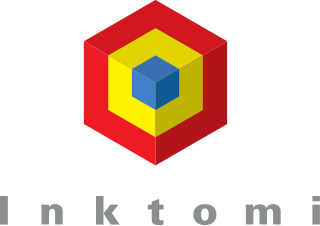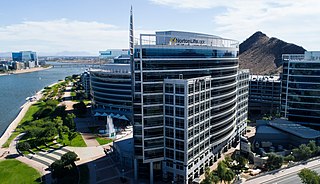
Inktomi Corporation was an American Internet service provider (ISP) software developer based in Foster City, California. Customers included Microsoft, HotBot, Amazon.com, eBay, and Walmart.

Novell, Inc. was an American software and services company headquartered in Provo, Utah, that existed from 1980 until 2014. Its most significant product was the multi-platform network operating system known as Novell NetWare. Novell technology contributed to the emergence of local area networks, which displaced the dominant mainframe computing model and changed computing worldwide.

Quark Software Inc. is a privately owned software company which specializes in enterprise publishing software for automating the production of customer communications. The company's original goal was to "create software that would be the platform for publishing", just as quarks are the basis for all matter.
Internet Security Systems, Inc., often known simply as ISS or ISSX, was a provider of security software and managed security services. It provided software and services for computers, servers, networks, and remote locations that involve preemptive security against threats before they affect a business. Founded in 1994, the company was acquired by IBM in 2006.

The SCO Group was an American software company in existence from 2002 to 2012 that became known for owning Unix operating system assets that had belonged to the Santa Cruz Operation, including the UnixWare and OpenServer technologies, and then, under CEO Darl McBride, pursuing a series of high-profile legal battles known as the SCO–Linux controversies.
J.D. Edwards World Solution Company or JD Edwards, abbreviated JDE, was an enterprise resource planning (ERP) software company, whose namesake ERP system is still sold under ownership by Oracle Corporation. JDE's products included World for IBM AS/400 minicomputers, OneWorld for their proprietary Configurable Network Computing architecture, and JD Edwards EnterpriseOne. The company was founded March 1977 in Denver, by Jack Thompson, C.T.P. "Chuck" Hintze, Dan Gregory, and C. Edward "Ed" McVaney.

Citrix Systems, Inc. is an American multinational cloud computing and virtualization technology company that provides server, application and desktop virtualization, networking, software as a service (SaaS), and cloud computing technologies. Citrix claims that their products are used by over 400,000 clients worldwide, including 99% of the Fortune 100 and 98% of the Fortune 500.

Gen Digital Inc. is a multinational software company co-headquartered in Tempe, Arizona and Prague, Czech Republic. The company provides cybersecurity software and services. Gen is a Fortune 500 company and a member of the S&P 500 stock-market index. The company also has development centers in Pune, Chennai and Bangalore. Its portfolio includes Norton, Avast, LifeLock, Avira, AVG, ReputationDefender, and CCleaner.

CA Technologies, Inc., formerly Computer Associates International, Inc., and CA, Inc., was an American multinational enterprise software developer and publisher that existed from 1976 to 2018. CA grew to rank as one of the largest independent software corporations in the world, and at one point was the second largest. The company created systems software that ran in IBM mainframe, distributed computing, virtual machine, and cloud computing environments.

OpenText Corporation is a Canadian Information company that develops and sells enterprise information management (EIM) software.

International Data Group is a market intelligence and demand generation company focused on the technology industry. IDG, Inc.'s mission is centered around supporting the technology industry through research, data, marketing technology, and insights that help create and sustain relationships between businesses.

Stratus Technologies, Inc. is a major producer of fault tolerant computer servers and software. The company was founded in 1980 as Stratus Computer, Inc. in Natick, Massachusetts, and adopted its present name in 1999. The current CEO and president is Dave Laurello. The founder of Stratus was Bill Foster. He served as CEO until Stratus was acquired by Ascend Communications in 1999. Prior to 2022, Stratus Technologies, Inc. was a privately held company, owned solely by Siris Capital Group. The parent company, Stratus Technologies Bermuda Holdings, Ltd., was incorporated in Bermuda. In 2022, the company was acquired by Smart Global Holdings (SGH) and currently operates within SGH's Intelligent Platform Solutions (IPS) business.

Radvision was a provider of video conferencing solution and enabling products for IP communication developers based in Tel Aviv, Israel. Radvision was acquired by Avaya in June 2012. Spirent Communications acquired Radvision's Technology Business Unit from Avaya in July 2014, to become Spirent Developer Tools Business Unit.
XML Professional Publisher (XPP) is an automated XML based publishing system that was developed out of a proprietary typesetting system.

Vignette Corporation was a company that offered a suite of content management, web portal, collaboration, document management, and records management software. Targeted at the enterprise market, Vignette offered products under the name StoryServer that allowed non-technical users to create, edit and track content through workflows and publish it on the web. It provided integration for enterprise resource planning, customer relationship management and legacy systems, supporting Java EE and Microsoft.NET. Vignette's integrated development environment and application programming interface offered an alternative to conventional Common Gateway Interface/vi/Perl web development. StoryServer was used on many large websites including those of CNET, UnitedHealth Group, The Walt Disney Company, Wachovia, Martha Stewart, Fox News, National Geographic Channel, Pharmacia & Upjohn, MetLife, BSkyB, the 2004 Summer Olympics, and NASA.
Page Interchange Language also known as Publishing Interchange Language, or "PIL" is a public domain language that allows precise description of the layout of content on pages, groups of multiple pages or any 2-dimensional area, which it calls a "canvas." It was developed between June 1990 and June 1991 by the Professional Publishers Interchange Specification Workgroup, a committee of software and hardware vendors serving the newspaper, magazine and print advertising markets. The committee was led by Quark and Atex.
TechnologyOne Limited is an Australian enterprise software company founded in 1987. The company is headquartered in Fortitude Valley in Brisbane, Australia, with other offices in United Kingdom, New Zealand, South Pacific and Asia. It is listed on the Australian Securities Exchange.

Altos Computer Systems was founded in 1977 by David G. Jackson and Roger William Vass Sr. It focused on small multi-user computers, starting with multi-user derivatives of CP/M, and later including Unix and Xenix-based machines. In its 1982 initial public offering on NASDAQ, the company raised $59M. Thereafter the company's stock was traded under the symbol ALTO.
Perforce Software, Inc. is an American developer of software used for developing and running applications, including version control software, web-based repository management, developer collaboration, application lifecycle management, web application servers, debugging tools, platform automation, and agile planning software.
Veritas Technologies LLC is an American international data management company headquartered in Santa Clara, California. The company has its origins in Tolerant Systems, founded in 1983 and later renamed Veritas Software. It specializes in storage management software including the first commercial journaling file system, VxFS, VxVM, VCS, the personal/small office backup software Backup Exec and the enterprise backup software, NetBackup. Veritas Record Now was an early CD recording software.












